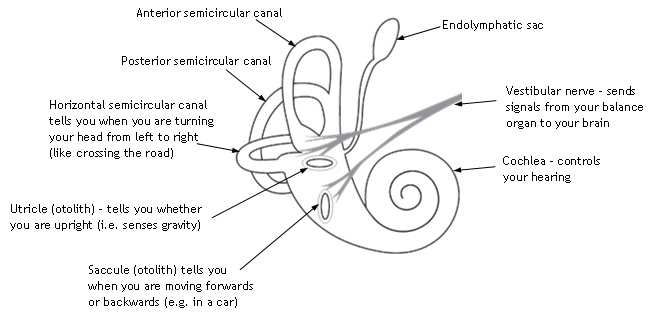Outer Ear
The outer ear is called the pinna and is made of rigid cartilidge covered by skin. Sound goes into the pinna down the external auditory canal until it reaches the eardrum, known as the tympanic membrane.
Middle Ear
Sound causes the eardrum and the tiny bones in the middle ear - the hammer, anvil and stirrup bones to vibrate. The stirrup fits in the oval window and that transmits sound to the cochlea in the inner ear. The middle ear space contains air, which gets in through the eustachian tube and this opens at the back of the nose.
Inner Ear
The inner ear contains the organs of hearing and balance.
The hearing organ is known as the cochlea. When sound passes through the middle ear, the fluids of the inner ear vibrate and trigger the little hair cells within the cochlea. The hair cells fire off electrical pulses. These pulses go down the nerve and are processed by the brain which is what we perceive as hearing.
The balance organ is known as the labyrinth and is made up of three fluid-filled chambers, known as the semicircular canals which send information on balance and head position to the brain, and two otolith organs, the saccule and utricle, which are responsible for sensing gravity and movement.

What do the different parts of my balance organ do?
The three semicircular canals (called the ‘horizontal’, ‘posterior’, and ‘anterior’ canals) are all at right angles to each other so that together they can detect movement across all the different angles you can move through. The ‘horizontal’ semicircular canal detects movements such as turning your head from left to right (e.g. when you are crossing the road). The ‘posterior’ and ‘anterior’ semicircular canals often work together and detect movements such as nodding your head up and down (e.g. when you are looking up at a high shelf), and tilting your head sideways (e.g. holding a phone between your ear and your shoulder). The two otoliths are called the utricle and the saccule. The utricle detects whether you are upright or lying down (using gravity), and the saccule detects whether you are moving forwards and backwards (e.g. in a car).
How can they tell when I am moving?
Each of the semicircular canals and the two otoliths are covered in tiny sensory hair cells. It is these hair cells that send balance signals back to the brain. The whole inner ear is filled with endolymphatic fluid. This fluid moves around your inner ear when you move. The hair cells in your balance organ are activated to send signals to your brain when they are moved by this fluid.
